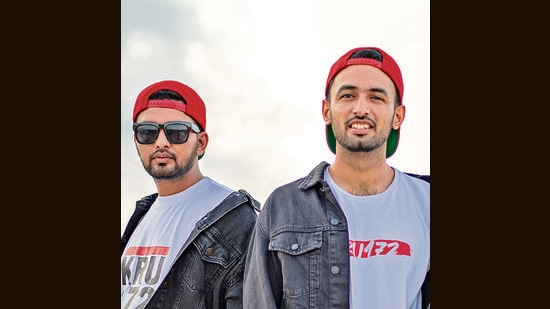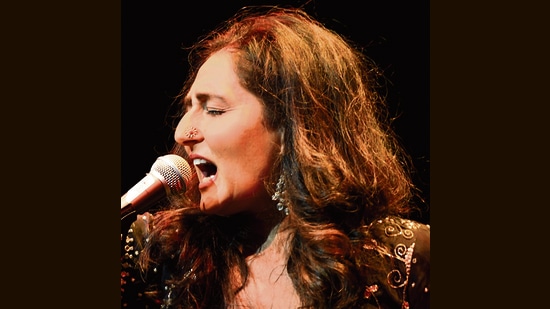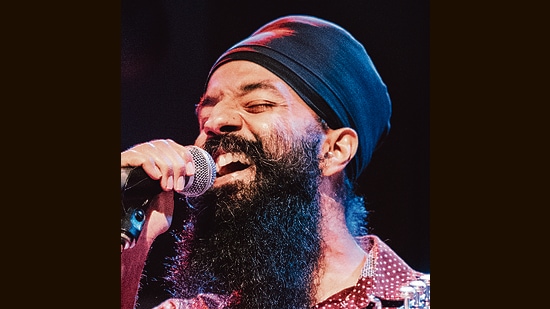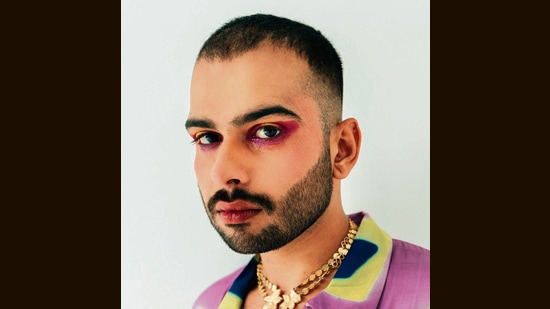The beats change. The themes change. Remixes are rare. “That’s because the Punjabi music market is very competitive and mature,” says Atul Churamani, managing director of the Mumbai-based Turnkey Music & Publishing. “A sense of saturation sets in very quickly, which promotes improvisation.”
Essentially, Punjabi music is a fast-moving stream. In part, this is because this music industry, unlike many others in India, has not been tied to its cinema (Punjabi cinema never took off in the early 80’s and 90’s, but has a niche following now). And so Punjabi pop has been both a consistent and a fast-changing presence. A tradition once rooted in ballads and folk traditions (think of Lal Chand Yamla Jatt in the 1950s) , then moved on to love songs by the likes of the legendaryLal Chand Yamla Jatt in the1980s, and further on to foot-tapping numbers full of double entendre by artists such as Amar Singh Chamkila (who was shot dead in 1988, aged 27, at the height of militancy in Punjab).
“The 1990s belonged to Punjabi pop, as a generation of expatriates sought out the music of their home state. They tuned in to songs by Punjabi-origin artists such as Apache Indian, Tarsame Singh Saini from the band Stereo Nation and Bally Sagoo,” says music journalist Narendra Kusnur. In an era of MTV and Channel V, these artists found listeners in India too, and successors such as Daler Mehndi, who debuted with Bolo Ta Ra Ra in 1995.
Mehndi was launched by the then-new recording label Magnasound. The album of the same name sold a million copies in its first year. Churamani, who was a part of the launch team, marks this as the point at which Punjabi pop became typified as “urban music with a rural touch and universal appeal”. “One lakh copies sold just in Kerala,” he says. “It had a peppy beat, easy-to-understand catchphrases and it got you on your feet.”
Punjabi pop / rap / hip hop / fusion would become typified by up-tempo rhythms, fast-paced beats and simple lyrics that were easy to understand for the Hindi speaker. Then, in the mid-2000s, YouTube came along and suddenly every Punjabi with a dream could be a popstar. The industry boomed; there are an estimated 400 record labels operational in Punjab today.
Today, the medium is often rap, but the lyrics have changed. Amid gangs, guns, drugs and a heightened race for status symbols, the songs are filled with machismo, violence, graphic descriptions of lust and women. Videos are considered incomplete without luxury cars, superbikes, guns and objectified women.
The music remains universal in its appeal. These are beats that one can drive to, work out to, party to or have on in the background. It’s a genre typified by the Indian-origin Canadian AP Dhillon, whose smash hit Excuses (2020), with a refrain that goes “Kehndi hundi si” (“She used to say”), sparked a viral meme trend.
***
That’s where we are in the mainstream. What YouTube (as well as Spotify, Apple Music and other such platforms) has also enabled is an increasingly vibrant independent Punjabi pop scene, and the lyrics, music and videos emerging here have almost nothing in common with the mainstream except the language.
A mix of Indian artists and artists from the diaspora are singing of identity, brotherly love, belonging, equal rights for races, genders and sexual minorities. Their songs include takes on fake news, racism, capitalism, the perils of unbridled urbanisation. Songs are being sung in dialects such as Puadhi (generally used to indicate a buffoon in Punjabi films and TV shows). Musical styles draw on kirtans and folk traditions as well as jazz, reggae, fado, alt-rock, electro-pop, punk rock and boom bap.
Punjabi rapper Sidhu Moose Wala was a rare musician who straddled both these worlds. Alongside his lyrics about guns and women, he sang in the Malwai dialect, hit out at politicians, the politics of religion, the failings of mainstream media. He spoke of the struggles of being “a Punjabi man”, holding a gun while battling inner turmoil. His death in a shooting in May prompted an outpouring of grief from rappers around the world, including the Canadian star Drake, the Briton Tion Wayne and America’s Russ.
Most of the artists operating outside the mainstream do not aim to make it that big. What they do want is to use Punjabi pop and rap as a means of expression and inclusion. It’s a new look for the industry. “I felt that this beautiful language needed to be explored in a whole different direction,” says Talwiinder, 27, a Tarn Taran boy now in California. “People like us, who are thick-skinned from all the trolling, are ready to take creative risks,” says Siddhant Soni, 27, a queer Punjabi rap artist in Delhi.
They might “live like a king one month and be broke the next”, adds artist Navdeep Singh, 34, but they’re singing about what matters: the right to love, an undivided India, a world of kindness and harmony as the Gurus envisioned it.
Kru 172 (Navdeep Singh and Harsimran Jit Singh)

Chandigarh shehar mera, des Punjab
Jithe jammeya main, ilaaka jo Puadh
Jithe loki bhole bhale, dil saaf jiven saadh
Jithe pyaar mile enna, jeehda koi ni hisaab.
(Chandigarh is my city, and I belong to Punjab
The place I was born in, is the region of Puadh
Where people are innocent, with crystal-clear hearts
Where you get so much love, you can’t tally it all up)
In popular Punjabi music, you hear of Doaba, Majha, Malwa. Never of Puadh. It’s a region that stood where Chandigarh is now. It’s where musicians Navdeep Singh, 34, and Harsimran Jit Singh, 30, are from.
The brothers grew up listening to stories of the village their grandfather grew up in, which ceded way at Independence for what is now Chandigarh’s Sector 34. They grew up speaking Puadhi, and having friends laugh at its unusual inflections.
They’re now singing in Puadhi, “to try and make the dialect cool again so that younger generations won’t hesitate to speak it,” says Navdeep aka Nav. He and his brother, who goes by Lucky, formed their band, Kru 172, in 2008. (0172 is Chandigarh’s STD code).
They grew up knowing they wanted to be musicians, Nav and Lucky say. Still, the former studied software engineering; and Lucky has a Master’s degree in psychology. “But nothing we did made us feel as complete as writing and creating music,” Nav says.
They started out in the mainstream, with songs of love and heartbreak set to the beats of reggaeton. Their first hit came in 2014, with Pare Ton Pare (Moving Farther Away), which got over 70,000 views on YouTube. In 2016, Shaukeen Balliye (The Trendy Boys) got over 500,000 views. Over the years, they collaborated with T-Series, Zee Music and Universal Music.
Then, in 2017, they changed direction. It started with a short parody song about brotherhood in which a young Puadhi man wants to know why no one thinks he’s cool. It led them to wonder why the dialect is made fun of as the “language of simpletons” in Punjabi films and TV shows. It got over 300,000 views, and the response encouraged the brothers to begin rapping in a mix of Puadhi and Punjabi.
This March, they released a hip hop album, Chandigarh’s Hottest Duo, with an intro that features their grand-uncle reminiscing about growing up in the mud houses of the village of Fatehgarh Madran. “We wanted to evolve from music everybody makes to themes that are more personal and that we feel strongly about. Our songs are now an extension of our identity,” Nav says.
Across the 10-track album, lyrics sing of pride in cultural identity; the crisis of inequality. Chal Uth Yaar (Let’s Go Man) takes a stand against divisive politics. “Our audience is the youth today, who are woke yet vulnerable. All they need is guidance in the right direction and they can bring about a revolution,” Nav says.
Themes the brothers plan to explore next include mental health struggles for musicians. “As a struggling indie artist, it can be hard to accept that you will live like a king one month and be broke the next,” Nav says.
They’ve been told they should bring the “gangsta vibes” back to their songs, but the brothers say they want to stick to music that is meaningful to them. “We realise that with great power comes great responsibility and would rather be heckled for not conforming to stereotypes than make music that we don’t identify with,” Nav says.
Kiran Ahluwalia

Born in Patna, raised in Canada and living in New York , Kiran Ahluwalia describes herself as a Punjabi with dual cultural citizenship. She thinks in multiple languages. Her music, she adds, is rooted in “the rigorous music training received in India” as well as the popular music she grew up listening to in Canada.
Her first brush with professional music began after she quit her job as a financial instruments trader in Toronto in the early ’90s, in search of something more fulfilling. She headed to India, where she spent a life-changing decade. “I ended up living in Mumbai, Hyderabad and Punjab, training in classical music, Punjabi and Sufi folk music,” she says.
She first began singing ghazals and Punjabi folk songs but soon after started writing original contemporary songs with themes of cultural tolerance, female desire, and rage against the middlemen of religion. She’s currently working on one song about discovering love over pancakes, and another about cultural and religious intolerance. “I’m very troubled by the marginalisation of Muslims and the general inequality amongst us, be it gender, caste or sexual orientation,” she says.
Over the course of seven albums (her first release was Kashish-Attraction, in 2000), Ahluwalia has received two JUNOs (Canada’s version of the Grammys), among other awards. She has also collaborated with the Malian group Tinariwen, Celtic fiddler Natalie MacMaster, Afghan musicians and several fado masters from Portugal. “It’s incredibly invigorating when I feel a connection in expressions from different cultures and can connect them seamlessly within my music. My goal is to make music that is a reflection of my identity.”
She has composed and sung for the soundtracks of films such as such the Oscar-winning Saving Face (2012), Some Kind Of Arrangement (1997; a documentary on evolving ideas of arranged marriage) and the feature film Versus Ivan (2004).
“Punjabi music has definitely galvanised Punjabi culture in the diaspora, having a distinct beat that brings the community together in joyous ways. But unfortunately I don’t hear many Punjabi songs that are spreading awareness on key issues. Even though I sing in Punjabi, I feel very much outside of the Punjabi music industry,” Ahluwalia says. “The audience plays an important role too. If they respond warmly to more meaningful topics then more singer-songwriters could take that leap of faith.”
Sonny Singh

Growing up in North Carolina, Sonny Singh was shaped, he says, by the racist bullying he encountered, particularly in school. As the only Sikh in most places – the school, park, mall – he had his turban pulled off by classmates in fifth grade. After 9/11, his turban would be pulled off again, on the New York subway, in 2006.
Through these decades, music was his refuge. He took up the trumpet at nine. As a teen, he was drawn to the lyrics of love and harmony in genres such as reggae and ska. “All music is political. What even is neutrality in a time when, around the world, fascism is growing and when anti-Muslim bigotry and caste oppression are mainstream?” says Singh, 42.
His music draws from gurbani (texts from the Guru Granth Sahib), which denounce tyranny and oppression and speak of love and oneness. But he started out spreading the word in quite a different way. After acquiring a Master’s degree in Education, he embarked on a career as a community organiser and social justice educator, conducting workshops on racial justice, oppression and social change.
Music remained a big part of his life. After moving to NYC for work, he co-founded the rock band Outernational at 23. When the band was offered a major record deal a few years later, he made music his career. In 2008, he also joined the bhangra fusion band Red Baraat, as trumpet-player and singer.
All the while, he’d continued to conduct his workshops on the side. Then, in 2019, Singh started recording short videos singing shabads or Sikh hymns on Instagram. Some of these amassed over 300,000 views and he realised that there was an audience out there for the music and the messages that meant the most to him.
“There is a lot of exciting, innovative Punjabi music being created in the world, but it’s usually mainstream music that gets all the attention,” he says. “Sadly, these default to the same old themes and tropes of sexism, hypermasculinity, violence. Perhaps, these issues are so entrenched in our communities, that it has been hard for most musicians to break out of them.”
In May 2022, Singh released his debut solo album, Chardi Kala, a Punjabi phrase that translates loosely as “eternal and revolutionary optimism”. He has sung the 11 tracks on the album. He has also played the trumpet and dhol. The songs are inspired by Sikh kirtans or devotional music, with music that draws from jazz, reggae and alt-rock.
He’s drawn some hate for this music — ironically, this time from Indians. When he sang in support of the anti-CAA activists, he was called “a Khalistani terrorist”; some Sikhs have taken offence at his use of shabads. “It’s exhausting, but I do believe those of us who believe in respect, dignity and social justice are in the majority and the tides will turn,” he says.
Singh also still performs with Red Baraat. “When I get up on a stage wearing my turban proudly, it feels like an act of resistance,” he says. “It’s been a difficult, beautiful, and unpredictable road as a professional musician who happens to be South Asian and Sikh, in New York City and touring the world.”
Siddhant Soni

Mai kalla jee reha haan
Kaude ghutt pee reha haan
Ghar di mainu yaad aave
Fer mainu yaad aave
Ki mai nakaara bacha
(I have been living alone
With a bitter pill to swallow
I miss my home
But then I remember
That I am an abandoned child)
Siddhant Soni is relatively new to the music industry, having quit his job as a creative director with a fashion brand to compose his first song, Bandeya (Friend), in October 2021. It was inspired by an uncomfortable conversation with a homophobic acquaintance.
“I was tired of creating art on contract. I wanted to write for myself. My songs are all an extension of me and my stories,” says the 27-year-old queer Punjabi rap artist based in Delhi.
In June 2022, Soni’s second song, Kalla Killah (Alone), about the alienation faced by members of the LGBTQ+ community, was re-released by Saregama Music. It was first released on Spotify in November last year and got 11,000 listens in a month, which prompted the music label to reach out to him to create a video for them.
The video for the track, which speaks of his years of turmoil, loneliness and hopelessness as a gay youngster, was created by an all-queer team. “I wrote from years of being confused about who I am, of being a ‘nakaara bacha’ or abandoned kid. But this applies to everyone. We’ve all felt this void in our lives at some point.”
Soni’s music is marked by a confluence of influences that date to his childhood in Hanumangarh, Rajasthan, where the large Partition-era immigrant population is made up of Sindhis, Marwaris and Punjabi-speaking Muslims, Hindus and Sikhs. “I grew up singing Punjabi folk songs at Sindhi weddings, learning Marwari wedding songs, which have captivating story-driven lyrics and could be interpreted as songs of love or of devotion,” he says.
Amid the secular celebrations and spiritual meets that spoke of seeking, believing and peace, music became a way for him to express his inner turmoil too. “When I started singing I felt like something within me had erupted. It was like I had finally found my voice after years of being a silent spectator in my own life,” he says. “Today, I sing in Punjabi, a language that is complex but is also truly me. It is also exciting to see how extensive the Punjabi music reach is, where people in villages are now listening to drill and boom bap music styles.”
His lyrics draw from folk songs and Sufi poetry, and speak of finding love for oneself, and finding love among friends and family. His biggest motivation in creating music, he says, is to slowly peel away the layers and let the world see his true self and thoughts. Working towards this transparency helped him come out to his parents, four years ago. He hopes his music will help others from marginalised communities speak out too.
“I believe that music transcends labels and if we can all share our stories, we will truly start respecting all identities,” he says. Stories like his are important to the Punjabi mainstream, he adds, because they bring to this field a sense of depth and variety. “People like us, who are thick-skinned from all the trolling, are ready to take creative risks.”
Talwiinder

Tu mera pehla roop hee jaandi
Mein tenu dooje baare v dass dinna
Tu sochi naa andron khush aa mein
Je tere saahmne mein thorha hass dinna
(You only know a version of me,
I’ll tell you a little about the other side
Just because I am smiling in front of you
Doesn’t mean I am happy within)
Moving from Tarn Taran in Punjab to California when he was 13, music became one of the things Talwinder Singh Sidhu clung to. He spoke barely any English, having studied in a Punjabi-medium school. “Music was a way I could pick up new words and try to fit in,” he says. “Meanwhile, my Punjabi friends in California were picking up their native language because I would break into Punjabi all the time.
When he started creating music of his own in 2015, it made sense to write in Punjabi. “It came from a sense of rebellion, where I was making my weakness my strength,” says Singh, 27, who goes by Talwiinder. “Mainstream Punjabi music is so much about macho bravado, money and cars. I also felt that this beautiful language needed to be explored in a whole different direction.”
In 2020, he quit his job as an investment banker to make music full-time. His first track, a work of drill rap titled Gaah (Chaos), is about not letting problems define one’s path. This May, he released a track called Her, on the surface a simple conversation between a boy and a girl, with, in the subtext, allusions to depression and anxiety. “It’s about the masks people wear in society and how we can’t really tell if someone needs help,” Talwiinder says. “I want my music to be there for some kid who is like me when I was 13. My music is for all the lost, confused Talwiinders out there.”
He seems to have struck a chord. Talwiinder has 128,000 subscribers on YouTube; songs such as Tera Saath have 2 million views. The self-taught musician follows his own process when it comes to making music — he records his songs over and over and uses them as case studies that he improves upon, by adding new beats and styles. “I experiment with lo-fi, electropop, drill, punk rock and jazz,” he says. “I also play the cajón and ukulele. I don’t want my audiences to be able to predict what song they will hear from me next.”
He prefers to keep his face, person and private life out of view, he adds. He often performs dressed as the Joker from Batman or wearing versions of skull face make-up. “I believe the music should do the talking, not my face, not my name or my identity,” he says.
Enjoy unlimited digital access with HT Premium
Subscribe Now to continue reading

Stay connected with us on social media platform for instant update click here to join our Twitter, & Facebook
We are now on Telegram. Click here to join our channel (@TechiUpdate) and stay updated with the latest Technology headlines.
For all the latest Art-Culture News Click Here

